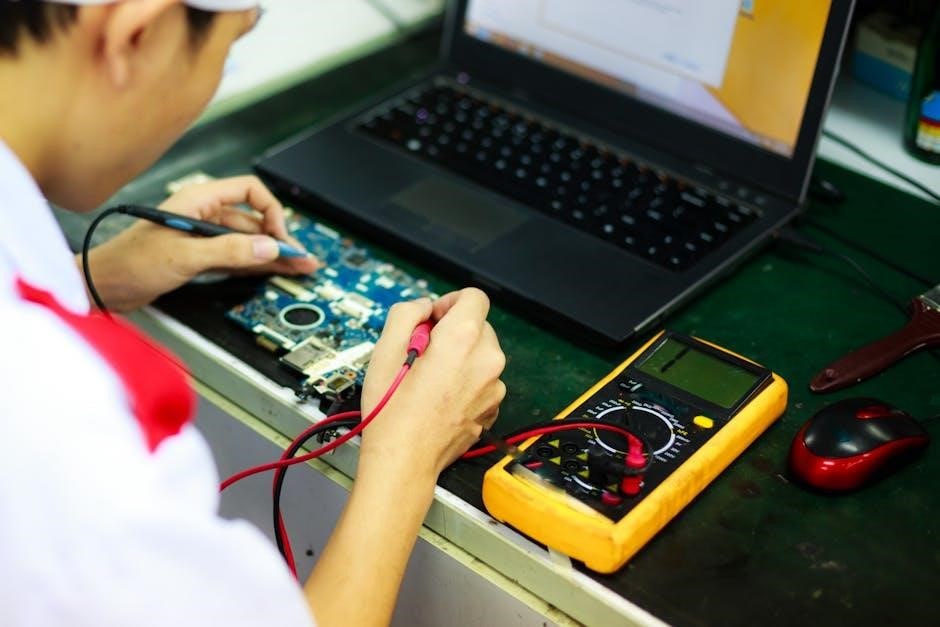This comprehensive guide addresses common issues encountered with Dometic AC units in RVs and motorhomes. We’ll cover troubleshooting steps for various problems, from poor ventilation to refrigerator resets. This guide helps you diagnose and resolve AC issues, ensuring a comfortable camping experience.
Common Dometic AC Problems
Dometic air conditioners, while reliable, can experience several common issues that impact their performance in RVs and motorhomes. One frequent problem is poor ventilation, often manifested as weak airflow from the vents. This can be caused by blocked ducts, a malfunctioning fan motor, or a dirty evaporator coil. Addressing poor ventilation is crucial for maintaining a comfortable temperature inside your vehicle.
Another common issue involves the Dometic refrigerator’s functionality, including problems with cooling or maintaining a consistent temperature. A potential solution involves resetting the refrigerator to clear any error codes or glitches that might be affecting its operation.
Furthermore, AC duct repair and regular cleaning are essential for optimal performance. Damaged or dirty ducts can significantly reduce airflow and cooling efficiency. Regular maintenance, including duct cleaning, helps ensure your Dometic AC operates effectively, providing the cooling you need while on the road. Identifying and addressing these common problems promptly can prevent more significant issues and costly repairs.
Poor Ventilation Issues
Poor ventilation in a Dometic AC system is a prevalent problem in RVs and motorhomes, often indicated by weak airflow from the vents. Several factors can contribute to this issue, including blocked or damaged air ducts. Obstructions such as debris, dust, or even collapsed ductwork can restrict airflow, reducing the AC’s cooling efficiency.
A malfunctioning fan motor can also cause poor ventilation. If the fan motor is not operating at its optimal speed, it will struggle to circulate air effectively through the duct system, leading to reduced airflow at the vents. Regular inspection and maintenance of the fan motor are crucial for ensuring proper ventilation.
Additionally, a dirty evaporator coil can significantly impede airflow. Dust and grime accumulate on the coil over time, restricting the passage of air and diminishing the AC’s cooling capacity. Cleaning the evaporator coil regularly can improve ventilation and enhance the overall performance of your Dometic AC system, ensuring a comfortable environment inside your RV or motorhome.
Resetting Dometic RV Refrigerator
Resetting your Dometic RV refrigerator can often resolve common operational issues and restore proper functioning. Before initiating a reset, ensure the refrigerator is turned off. Locate the power switch or circuit breaker dedicated to the refrigerator and switch it off. Allow the refrigerator to remain without power for approximately 15-20 minutes. This pause allows the system to fully discharge and clear any lingering errors.

After the waiting period, restore power to the refrigerator by turning the switch or breaker back on. Observe the refrigerator’s control panel for any error codes or unusual indicators. If the refrigerator starts operating normally, the reset was successful.
However, if the issues persist or error codes reappear, further troubleshooting may be necessary. Consult the Dometic RV refrigerator’s user manual for specific error code descriptions and recommended solutions. If the problem remains unresolved, seeking assistance from a qualified RV technician is advisable to diagnose and repair any underlying issues. Regular maintenance and timely resets can help maintain optimal performance.
AC Duct Repair and Cleaning
Maintaining clean and well-repaired AC ducts is crucial for optimal cooling efficiency in your RV or motorhome. Over time, dust, debris, and mold can accumulate within the ductwork, restricting airflow and diminishing the AC unit’s performance. Regular cleaning can significantly improve air quality and cooling effectiveness.
Begin by inspecting the ductwork for any visible damage, such as cracks or leaks. Seal any identified leaks with appropriate duct tape or sealant to prevent air loss. To clean the ducts, use a vacuum cleaner with a hose attachment to remove loose debris. For more thorough cleaning, consider using a specialized duct cleaning kit designed for RVs.
These kits often include brushes and cleaning solutions to dislodge stubborn dirt and mold. Ensure proper ventilation while cleaning and allow the ducts to dry completely before reassembling. Regular inspection, repair, and cleaning of your AC ducts will ensure efficient cooling and a healthier environment inside your RV. If you are not comfortable performing these tasks yourself, seek professional assistance.

Dometic AC ⎼ Quick Fixes
Discover easy solutions for common Dometic AC problems. These quick fixes address issues like poor ventilation and simple malfunctions. Try these troubleshooting steps before seeking professional service to potentially save time and money on minor AC repairs in your RV.
Troubleshooting Steps for Poor Ventilation
Experiencing weak airflow from your Dometic RV AC vents? Poor ventilation is a common issue that can often be resolved with simple troubleshooting. First, check the air filter. A dirty or clogged filter restricts airflow significantly. Replace or clean the filter as needed to ensure proper ventilation throughout your RV.
Next, inspect the AC ducts for any obstructions or disconnections. Animals or debris can sometimes block the ducts, hindering airflow. Ensure all duct connections are secure and properly sealed to prevent air leaks. Air leaks reduce the efficiency of your AC system and diminish airflow to desired areas.
Additionally, examine the evaporator coils for ice buildup. Icing can occur due to low refrigerant levels or restricted airflow. If ice is present, turn off the AC and allow the coils to thaw completely. Once thawed, investigate the cause of the icing and address it accordingly. This might involve adding refrigerant or improving airflow.
Finally, confirm that the blower fan is functioning correctly. A malfunctioning blower fan will reduce airflow regardless of other factors. Listen for unusual noises or vibrations from the fan, and if necessary, consult a professional for repair or replacement to restore optimal ventilation.

Spare Parts and Technical Documentation
Accessing the correct spare parts and technical documentation is vital for Dometic AC repairs. Locate parts lists and understand documentation guidelines for efficient troubleshooting and maintenance. This ensures accurate repairs and extends the lifespan of your Dometic AC unit.
Locating Spare Parts Lists
Finding the correct spare parts list for your specific Dometic AC model is crucial for successful repairs. Start by identifying the model number, typically found on a label inside the unit or on the exterior housing. Once you have the model number, you can utilize several resources to locate the corresponding parts list.
Dometic’s Official Website: The Dometic website is the primary source for official documentation. Navigate to the “Support” or “Service” section and search for your model number. You should find downloadable parts lists in PDF format.
Authorized Dealers: Contacting an authorized Dometic dealer is another reliable option. They can provide you with the correct parts list and assist in ordering the necessary components. Dealers often have access to updated information and can offer expert advice.
Online Parts Retailers: Several online retailers specialize in RV and appliance parts. These websites often have parts lookups based on model number. Be sure to verify the compatibility of the parts with your specific AC unit before placing an order.
RV Forums and Communities: Online RV forums and communities can be valuable resources. Members may have access to parts lists or be able to direct you to the appropriate sources.
Always double-check the parts list against your AC unit to ensure compatibility before ordering any components. Using the wrong parts can lead to further damage or malfunction.
Understanding Technical Documentation Guidelines
Dometic’s technical documentation provides essential information for servicing and repairing their AC units. Understanding these guidelines is crucial for accurate diagnosis and effective repairs. These documents often include wiring diagrams, component specifications, troubleshooting flowcharts, and exploded views of the unit.
Wiring Diagrams: These diagrams illustrate the electrical connections within the AC unit. They are essential for tracing circuits, identifying faulty components, and ensuring proper wiring during repairs. Pay close attention to wire colors and connector locations.
Component Specifications: This section provides detailed information about each component, including voltage, amperage, and resistance values. These specifications are necessary for testing components and determining if they are functioning correctly.
Troubleshooting Flowcharts: These flowcharts guide you through a systematic process of diagnosing problems. They typically involve a series of questions and tests to isolate the source of the issue;
Exploded Views: Exploded views provide a visual representation of how the AC unit is assembled. They are helpful for disassembling and reassembling the unit, as well as identifying the location of specific parts. When consulting technical documentation, always refer to the document that corresponds to your specific Dometic AC model. Variations exist between models, and using the wrong information can lead to incorrect diagnoses or repairs.

Service and Repair
Proper service and repair are essential for maintaining the performance of your Dometic AC. Regular maintenance, like AC duct cleaning, prevents costly repairs. When issues arise, professional RV service technicians can accurately diagnose and fix them, ensuring optimal AC operation for your RV or motorhome.
RV and Motorhome AC Service
Maintaining a comfortable environment inside your RV or motorhome relies heavily on a properly functioning air conditioning system. Dometic AC units, while reliable, require regular service to ensure optimal performance. This includes routine inspections, cleaning, and timely repairs. Neglecting these services can lead to decreased efficiency, higher energy consumption, and eventual system failure.
RV and motorhome AC service typically involves checking refrigerant levels, inspecting electrical components, and cleaning the condenser and evaporator coils. Dirty coils reduce the AC’s ability to transfer heat, forcing it to work harder and consume more power. Duct cleaning is also crucial, as dust and debris can accumulate, restricting airflow and potentially harboring mold or allergens. Proper airflow is essential for efficient cooling and a healthy living environment.
When problems arise, prompt and professional service is essential. Experienced technicians can diagnose issues accurately and perform necessary repairs, preventing further damage and ensuring the longevity of your Dometic AC unit. Regular service not only maintains comfort but also protects your investment in your RV or motorhome. Remember to consult your Dometic AC’s manual for specific service recommendations and intervals.

